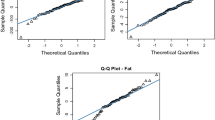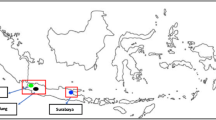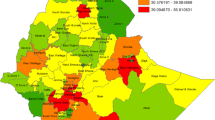Abstract
In recent times, India has achieved significant advancement on several health indicators while the state of food security in the country still needs sustained efforts to accelerate attainment. Existing data based on socio-economic surveys conducted by National Sample Survey Office (NSSO) produce precise measures of food security status at state and national level. However, these NSSO surveys cannot be used directly to produce reliable district or further smaller domain level estimates because of small sample sizes which lead to high level of sampling variability. As food security is often unevenly distributed among the subsets of relatively small areas, the availability of disaggregate (e.g. district) level statistics for target oriented effective policy planning and monitoring is the need of the hour for decentralized administrative planning system in India. But, due to lack of district level estimates, the mapping and analysis related to food and nutrition security measures are restricted to state and national level. As a result, disaggregate level dissimilarity and variability existing in food and nutrition security are often masked. This article delineates multivariate small area estimation (SAE) technique to obtain reliable and representative model-based estimates of food insecurity indicators at district level for the rural areas of state of Uttar Pradesh in India by combining latest round of available Household Consumer Expenditure Survey 2011–12 data of NSSO and the Indian Population Census 2011. The empirical evidence indicate that the estimates generated by SAE approach are reliable and representative. Spatial maps showing district level inequality in distribution of food insecurity in Uttar Pradesh is also produced. The disaggregate level estimates and spatial maps of food insecurity are directly relevant to sustainable development goal indicator 2.1.2 - severity of food insecurity. The estimates and maps of food insecurity indictors are anticipated to offer irreplaceable information to administrative decision-makers and policy experts for identifying the regions requiring more attention. Government of India has recently launched number of schemes for the benefit of rural population in the country and these estimates will be useful for fund allocation as well as in the monitoring of these schemes.








Similar content being viewed by others
References
Anjoy, P., Chandra, H., & Basak, P. (2019). Estimation of disaggregate-level poverty incidence in Odisha under area-level hierarchical bayes small area model. Social Indicators Research, 144, 251–273.
Benavent, R., & Morales, D. (2016). Multivariate Fay–Herriot models for small area estimation. Computational Statistics and Data Analysis, 94, 372–390.
Brown, G., Chambers, R., Heady, P., & Heasman, D. (2001). Evaluation of small area estimation methods: An application to unemployment estimates from the UK LFS. Proceedings of Statistics Canada Symposium 2001. Achieving data quality in a statistical agency: A methodological perspective.
Census. (2011). Primary census abstracts, Registrar General of India, Ministry of Home Affairs, Government of India. http://www.censusindia.gov.in/2011census/population_enumeration.html
Chandra, H., Salvati, N., & Sud, U. C. (2011). Disaggregate-level estimates of indebtedness in the state of Uttar Pradesh in India-an application of small area estimation technique. Journal Applied Statistics, 38(11), 2413–2432.
Chandra, H. (2013). Exploring spatial dependence in area level random effect model for disaggregate level crop yield estimation. Journal of Applied Statistics, 40(4), 823–842.
Chandra, H., Salvati, N., & Chambers, R. (2015). A spatially nonstationary Fay-Herriot model for small area estimation. Journal of Survey Statistics and Methodology, 3(2), 109–135.
Datta, G.S., Fay, R.E., & Ghosh, M. (1991). Hierarchical and empirical Bayes multivariate analysis in small area estimation. In: Proceedings of Bureau of the Census 1991 Annual research conference, US Bureau of the Census, Washington, DC, 63–79.
Datta, G. S., & Lahiri, P. (2000). A unified measure of uncertainty of estimated best linear unbiased predictors in small area estimation problems. Statistica Sinica, 10, 613–627.
Datta, G., Kubokawa, T., Molina, I., & Rao, J. N. K. (2011). Estimation of mean squared error of model-based small area estimators. TEST, 20(2), 367–388.
Fay, R. E., & Herriot, R. (1979). Estimates of income for small places: An application of James stein procedures to census data. Journal of the American Statistical Association, 74, 269–277.
Fay, R. E. (1987). Application of multivariate regression of small domain estimation. In R. Platek, J. N. K. Rao, C. E. Särndal, & M. P. Singh (Eds.), Small area statistics (pp. 91–102). New York: Wiley.
Foster, J., Greer, J., & Thorbecke, E. (1984). A class of decomposable poverty measures. Econometrica, 52(3), 761–766.
GHI (2020). Global Hunger Index 2020. https://www.globalhungerindex.org/results.html
González-Manteiga, W., Lombardía, M. J., Molina, I., Morales, D., & Santamaría, L. (2010). Small area estimation under Fay–Herriot models with nonparametric estimation of heteroscedasticity. Statistical Modelling, 10(2), 215–239.
Gopalan, C., Rama Sastri, B. V., & Balasubramanian, S. C. (1991). Nutritive values of Indian foods. Hyderabad: National Institute of Nutrition.
Government of India. (2014). Nutritional Intake in India, 2011–12. 68th Round, Report No. 560, National Sample Survey Organisation (NSSO). Ministry of Statistics and Programme Implementation. New Delhi.
Hossain, M. J., Das, S., Chandra, H., & Islam, M. A. (2020). Disaggregate level estimates and spatial mapping of food insecurity in Bangladesh by linking survey and census data. PLoS One, 15(4), e0230906. https://doi.org/10.1371/journal.pone.0230906.
Islam, S., & Chandra, H. (2019). Small area estimation combining data from two surveys. Communications in Statistics - Simulation and Computation, 1–22. https://doi.org/10.1080/03610918.2019.1588308.
Marhuenda, Y., Molina, I., & Morales, D. (2013). Small area estimation with spatio-temporal Fay–Herriot models. Computational Statistics and Data Analysis, 58, 308–325.
Morales, D., Pagliarella, M. C., & Salvatore, R. (2015). Small area estimation of poverty indicators under partitioned area-level time models. SORT, 39(1), 19–34.
MosPI, Government of India & WFP (2019). Food and nutrition security analysis, India, 2019. Ministry of Statistics and Programme Implementation & the World Food Programme. http://mospi.nic.in/sites/default/files/publication_reports/document%281%29.pdf
NITI Aayog. (2019). SDG India Index. https://sdgindiaindex.niti.gov.in
Prasad, N. G. N., & Rao, J. N. K. (1990). The estimation of the mean squared error of small-area estimators. Journal of the American Statistical Association, 85, 163–171.
Rao, J. N. K., & Molina, I. (2015). Small area estimation (2nd ed.). New York: Wiley.
Rao, J. N. K., & Yu, M. (1994). Small-area estimation by combining time-series and cross-sectional data. The Canadian Journal of Statistics, 22(4), 511–528.
UNDP. (2015). Sustainable Development Goals. https://www.undp.org/content/undp/en/home/sustainable-development-goals.html
Acknowledgments
The authors would like to acknowledge the valuable comments and suggestions of the Editor and two referees. These led to a considerable improvement in the paper. The work was carried out under the ICAR-National Fellow Project at ICAR-IASRI, New Delhi, India.
Author information
Authors and Affiliations
Corresponding author
Ethics declarations
Conflict of interest
The authors declared that they have no conflict of interest.
Rights and permissions
About this article
Cite this article
Guha, S., Chandra, H. Measuring disaggregate level food insecurity via multivariate small area modelling: evidence from rural districts of Uttar Pradesh, India. Food Sec. 13, 597–615 (2021). https://doi.org/10.1007/s12571-021-01143-1
Received:
Accepted:
Published:
Issue Date:
DOI: https://doi.org/10.1007/s12571-021-01143-1




